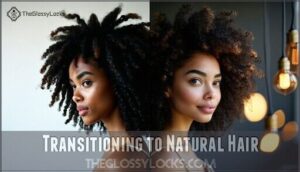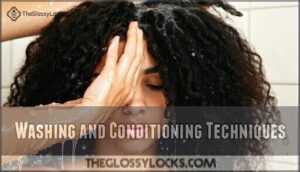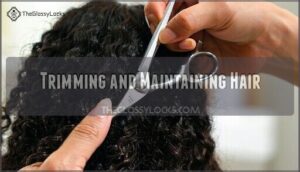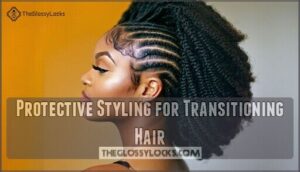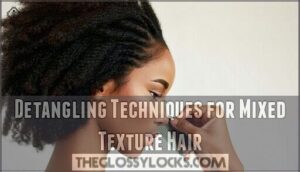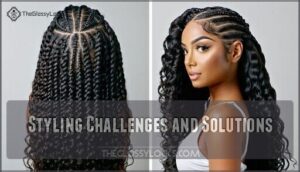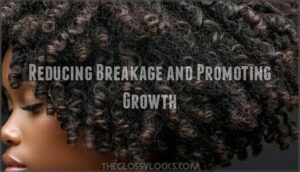This site is supported by our readers. We may earn a commission, at no cost to you, if you purchase through links.
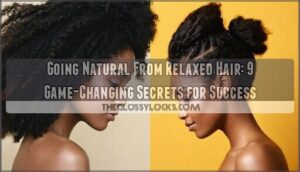 Going natural from relaxed hair is a journey that requires patience and care, but it’s absolutely worth it.
Going natural from relaxed hair is a journey that requires patience and care, but it’s absolutely worth it.
Start by choosing between the big chop or gradually growing out your relaxer. Keep your hair moisturized to prevent breakage, and use products designed for both textures.
A wide-tooth comb will be your best friend during detangling. Protective styles like braids or twists can help you manage the shift while limiting damage.
Don’t forget to trim the relaxed ends over time. Making the change is more than hair—it’s about embracing your natural beauty.
Ready to feel empowered? There’s so much more to discover!
Table Of Contents
- Key Takeaways
- Transitioning to Natural Hair
- Top 9 Natural Hair Products
- 1. tgin Honey Miracle Hair Mask
- 2. Camille Rose Curl Defining Gel
- 3. Pantene Gold Series Hair Kit
- 4. Camille Rose Algae Hair Mask
- 5. Head Shoulders Royal Oils Scalp Cream
- 6. Curls Blueberry Bliss Twist Out Cream
- 7. SheaMoisture Coconut Oil Skin Hair Hydration
- 8. Leven Rose Organic Jojoba Oil
- 9. Pure Tea Tree Oil for Skin
- Healthy Hair Routine Tips
- Managing Two Textures Effectively
- Achieving Successful Transition
- Frequently Asked Questions (FAQs)
- Can you transition from relaxed hair to natural?
- What to do if your hair is relaxed but you want to go natural?
- Can you get your natural hair texture back after a relaxer?
- How can stress impact hair growth during transitioning?
- What role does diet play in healthier hair growth?
- Are there supplements that accelerate natural hair growth?
- How does water quality affect hair hydration and strength?
- What is the best way to address scalp dryness?
- Conclusion
Key Takeaways
- Choose between the big chop for an immediate switch to natural hair or grow out your relaxer gradually while trimming ends regularly.
- Keep your hair moisturized with water-based products and oils to prevent breakage and maintain healthy growth.
- Use protective styles like braids or twists to manage two textures and minimize damage during the transition.
- Join supportive communities and focus on consistent care to stay motivated and successfully embrace your natural texture.
Transitioning to Natural Hair
You’ll need patience and the right care routine when switching from relaxed to natural hair.
Your journey requires choosing between the big chop method or gradually growing out your relaxer while maintaining healthy hair practices.
Big Chop Method
The big chop often represents the ultimate leap of faith in your natural hair journey.
You’ll instantly switch by cutting off all relaxed hair, leaving only your natural texture. This method requires mental length detachment but offers immediate freedom from managing two textures.
Many women find this confidence boost liberating, though styling options may initially be limited during your regrowth journey.
Consider using the right hair products for your hair type. It’s bold, but incredibly rewarding.
Growing Out Relaxer
Unlike the big chop, growing out your relaxer requires significant patience levels.
You’ll need to manage the demarcation line where your natural texture meets relaxed ends.
Regular trimming frequency (every 6-8 weeks) helps remove damaged ends gradually.
Maintain moisture balance with hydrating products to prevent breakage.
Protective styles like braids or twists can hide two textures while your natural hair grows.
This method preserves length while you shift to natural hair.
Mental Preparation
While growing out your relaxer requires patience, the mental side needs just as much care. Your natural hair journey begins in your mind.
To prepare mentally:
- Accept that your definition of beauty might change
- Research natural hair journeys to set realistic expectations
- Find supportive communities online or in-person
- Create a vision board with natural hairstyles you love
Remember, embracing change takes time. Building confidence happens gradually as you discover your hair’s true potential.
Commitment to Transition
During your natural hair journey from relaxed to natural, commitment isn’t just a one-time decision.
You’ll need patience levels beyond what you might expect. Set realistic expectations and small goals to track progress.
Avoid setbacks by sticking to your routine, even when it’s tempting to reach for relaxers. Keep a long-term vision in mind—this journey takes time but rewards consistency.
Top 9 Natural Hair Products
You’ll need the right products to help your hair evolve from relaxed to natural without damage or excessive breakage.
These nine essential products will nourish your strands, protect your scalp, and make your journey to natural hair smoother and more successful.
1. tgin Honey Miracle Hair Mask
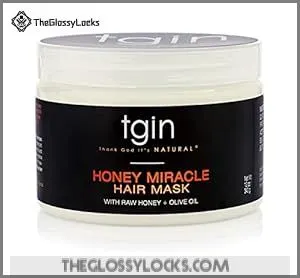
Your hair’s transformation starts with tgin Honey Miracle Hair Mask, a luxurious deep conditioner perfect for dry or damaged strands during the repair process.
This sulfate-free, Black-owned product combines raw honey, jojoba oil, and olive oil to nourish and strengthen your hair.
Apply generously, cover with a plastic cap, and let it work for 10-15 minutes under heat or 30-60 minutes without.
Users report impressive softness, shine, and moisture without heaviness, and it’s especially effective for low porosity hair and helps reduce breakage while promoting healthier growth.
The mild floral scent is a bonus.
Best For: individuals with dry, damaged, or color-treated hair, particularly those with low porosity hair or curly hair types, including 4c hair.
- Restores and repairs dry, damaged, or color-treated hair with raw honey, jojoba oil, and olive oil
- Provides long-lasting moisture and shine without weighing hair down
- Reduces breakage and promotes healthier, stronger hair growth
- Some users reported packaging issues, such as broken seals during shipping
- Mixed reviews on long-term curl definition and maintenance
- Not recommended for users who received unsealed or potentially counterfeit products
2. Camille Rose Curl Defining Gel
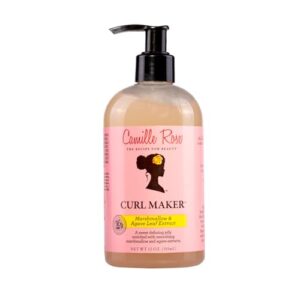
You’ll love Camille Rose Curl Defining Gel for its strong hold and moisturizing properties.
It defines curls without crunchiness, thanks to marshmallow root extract.
This gel is perfect for curly, coily, and kinky hair textures, providing a smooth finish and reducing frizz.
Proper application can also enhance natural curl formation.
Apply it to wet hair for best results and enjoy bouncy, healthy-looking curls.
Best For: individuals with curly, coily, and kinky hair textures looking for a strong hold and moisturizing properties in a curl defining gel.
- Defines curls without crunchiness, thanks to marshmallow root extract
- Provides strong hold and moisturizing properties for healthy-looking curls
- Reduces frizz and enhances natural curl formation for a smooth finish
- Some users note differences in product quality when purchased from different retailers
- Mixed reviews on stickiness, with some finding it underwhelming or too sticky
- Not explicitly marketed as a volumizing product, though it defines curls well
3. Pantene Gold Series Hair Kit
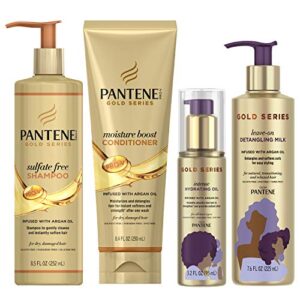
With the Pantene Gold Series Hair Kit, you’re getting a powerful tool to nourish your locks.
This kit contains an 8.5 oz shampoo and 8.4 oz conditioner, infused with argan oil for deep moisture.
It helps prevent breakage, improves elasticity, and retains hair length, making it perfect for regrowing hair.
Use it daily for soft, manageable hair.
Best For: people with textured, frizzy, dry, and curly hair types who want to nourish and moisturize their locks.
- Infused with argan oil for deep moisture and nourishment
- Helps prevent hair breakage, improves elasticity, and retains hair length
- Provides soft, manageable hair with daily use
- Manufactured in China, which may be a concern for some users
- Caution advised against using too much product, which can be inconvenient
- Limited information available about the long-term effects of using the product
4. Camille Rose Algae Hair Mask
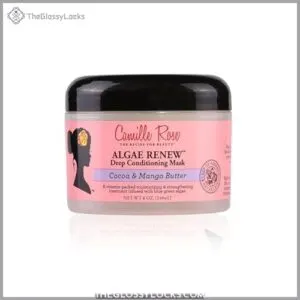
By incorporating the Camille Rose Algae Hair Mask into your routine, you’re strengthening your hair and locking in moisture.
This mask, infused with cocoa and mango butter, prevents thinning and breakage, making it a game-changer for your natural hair journey.
It’s suitable for all hair types, providing intense hydration.
Best For: individuals with dry, curly, and coily hair who need intense hydration and strengthening of their hair.
- Provides long-lasting moisture and softness to the hair
- Suitable for all hair types, including high and low porosity hair
- Effective in detangling, softening, and enhancing curls
- Considered expensive by some users
- Packaging is criticized for being wasteful and environmentally unfriendly
- Some users have reported issues with packaging, including open seals and incomplete product filling
5. Head Shoulders Royal Oils Scalp Cream
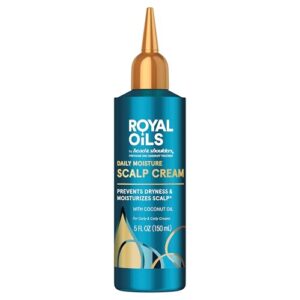
You’re considering Head & Shoulders Royal Oils Scalp Cream, designed for black hair by black scientists.
This no-rinse, alcohol-free formula provides scalp relief and luxurious moisture.
It’s infused with cooling menthol and peppermint oil, offering 24-hour scalp protection.
Use it between washes for natural, relaxed, or textured hair, and enjoy its soothing benefits.
Best For: individuals with natural, relaxed, kinky, textured, and coily hair types who need a no-rinse, alcohol-free formula for scalp relief and luxurious moisture.
- Some users find the product expensive
- Packaging issues have been reported, with product sticking inside
- The 4.2 fl oz size may be used quickly with regular application
- Provides 24-hour scalp protection with regular use
- Infused with cooling menthol and peppermint oil for a soothing sensation
- Suitable for various hair types, including dreadlocks and protective styles
6. Curls Blueberry Bliss Twist Out Cream
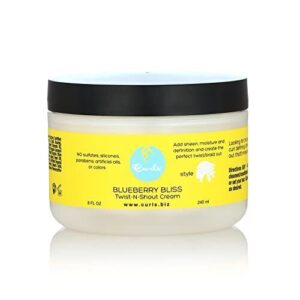
You’re looking for a great twist-out cream.
Curls Blueberry Bliss Twist Out Cream is a lightweight, creamy product that enhances natural texture and imparts shine.
It contains certified organic blueberry extract, coconut oil, and other botanicals.
Apply it to damp hair, twist or braid, and let it dry for a beautiful, defined look using the Curls Blueberry Bliss Twist Out Cream.
Best For: individuals with curly hair, particularly those looking for a lightweight and creamy product to enhance their natural texture and define their curls.
- Enhances natural texture and imparts shine to curly hair
- Contains certified organic blueberry extract, coconut oil, and other beneficial botanicals
- Lightweight and creamy consistency, making it ideal for twist-outs and braid-outs without weighing hair down
- May be considered pricey, especially when combined with other products in the range
- Not suitable for those sensitive to strong fragrances
- May require experimentation to find the optimal amount for individual hair types and needs
7. SheaMoisture Coconut Oil Skin Hair Hydration
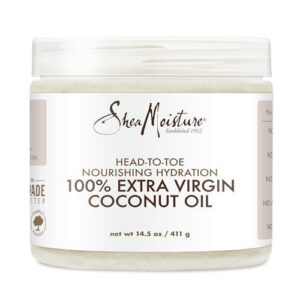
You’ll love SheaMoisture Coconut Oil Skin Hair Hydration, a 100% virgin coconut oil product.
It softens and restores hair and skin, aiding in moisture retention. This fast-absorbing, non-greasy formula is suitable for hair, face, hands, body, and feet, leaving radiant skin without greasy residue.
Use it to hydrate your hair and skin.
Best For: adults with dry and combination skin types who need a natural moisturizer for their hair and skin.
- Softens and restores hair and skin, aiding in moisture retention
- Fast-absorbing, non-greasy formula suitable for hair, face, hands, body, and feet
- Made with 100% Virgin Coconut Oil, free from common harsh chemicals like parabens, phthalates, mineral oil, and sulfates
- May not be suitable for oily skin types due to its rich and nourishing formula
- Can be used as a moisturizer but may not provide long-lasting hydration for extremely dry skin
- No specific instructions for storage or shelf life are provided, which may affect its quality over time
8. Leven Rose Organic Jojoba Oil
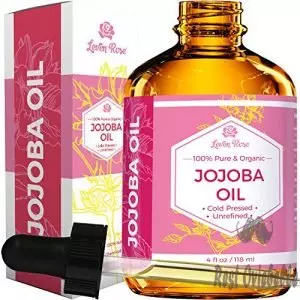
You use Leven Rose Organic Jojoba Oil to add shine and strength to your hair.
This oil is a humectant, providing moisturizing benefits for all hair types.
It restores resilience and moisture, making it ideal for natural hair care.
With its pure, organic ingredients, it’s a great addition to your hair routine, promoting healthy and strong hair growth.
Best For: Individuals seeking a natural, organic solution to moisturize and strengthen hair, skin, and nails without irritation.
- 100% natural, organic, and cruelty-free ingredients.
- Multi-purpose use for hair, skin, and nails.
- Lightweight and non-comedogenic, ideal for acne-prone skin.
- Strong oil aroma that may linger on clothing or in rooms.
- Requires careful rinsing to avoid any greasy residue.
- Less effective compared to specialized makeup removers.
9. Pure Tea Tree Oil for Skin
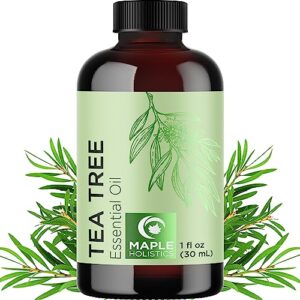
Tea tree oil is like a superhero for your scalp! Its cleansing and hydrating powers can tackle dry, flaky patches while keeping your hair refreshed.
You’ll want to dilute it with a carrier oil, such as coconut or jojoba, for safe and effective application. Massage it into your scalp for added stimulation and moisture.
Beyond scalp care, tea tree oil purifies nails and even supports shiny, strong hair growth. It’s a natural multitasker you’ll come back to again and again!
Best For: Individuals seeking a natural solution for scalp health, nail care, and skin hydration.
- Multi-purpose use for hair, skin, and nail care.
- Provides cleansing and hydrating benefits for flaky scalps.
- Promotes stronger, shinier nails.
- Requires dilution with carrier oil before use.
- May lack strong scientific support for some claims.
- Packaging issues such as leaks or broken seals reported.
Healthy Hair Routine Tips
Creating a healthy hair routine is key to moving from relaxed to natural hair successfully. Focus on consistent washing, moisturizing, and protective styling to keep your strands strong and manageable.
Washing and Conditioning Techniques
Washing and conditioning while moving to natural hair is essential for healthy growth.
Follow these tips:
- Try co-washing natural hair to gently cleanse and lock in moisture.
- Use sulfate-free shampoos to avoid stripping oils.
- Deep conditioning weekly restores softness and elasticity.
- Rinse with lukewarm water, then use protein treatments monthly for stronger strands.
Consider using products that lack harsh chemicals for gentle cleansing.
Consistency is key, and following these steps will help achieve stronger strands.
Moisturizing and Hydrating Methods
Keeping your hair moisturized begins with thoughtful hydration techniques.
Layer products with water-rich ingredients, like aloe vera or shea butter, to lock in moisture.
Oils seal hydration into strands, while DIY remedies like apple cider rinses nourish the scalp.
Stick to deep conditioning weekly for softness.
Here’s a quick cheat sheet:
| Step | Technique | Benefit |
|---|---|---|
| Hydration | Aloe vera gel | Adds moisture |
| Oil Application | Coconut oil | Seals cuticle |
| DIY Remedies | Apple cider rinse | Nourishes scalp |
The provided table outlines specific steps for hair care, including Hydration and Oil Application, to help maintain healthy and moisturized hair.
Trimming and Maintaining Hair
Healthy hair starts with regular trimming to manage breakage and prevent split ends, especially at the demarcation line.
Aim for professional trims every 6-8 weeks to maintain shape and health. Invest in sharp, quality trimming tools for at-home upkeep.
To prevent further damage, consider the benefits of regular hair trimming. This step is key in your natural hair journey, keeping both relaxed and natural strands strong as you grow forward with proper care.
Protective Styling for Transitioning Hair
Protective styling is key for a smooth natural hair journey. It shields your hair, reduces breakage, and promotes growth when done right.
Focus on tension control, moisture retention, and scalp health to avoid setbacks. Many people find success using specialized style products.
- Rotate styles to maintain scalp health and prevent breakage.
- Moisturize regularly for style longevity and hydration.
- Choose products that nourish, like sulfate-free sprays or oils.
Managing Two Textures Effectively
Managing two different textures can feel tricky, but it’s all about consistency and care. Focus on keeping both textures moisturized and protected to reduce breakage and maintain healthy growth.
Detangling Techniques for Mixed Texture Hair
Tackling mixed textures isn’t hard with the right tools.
Wet detangling works wonders—hydrate with conditioner, then section hair. Gently use wide-tooth combs or your fingers. Avoid pulling to prevent hair breakage.
Here’s a quick guide:
| Technique | Best For |
|---|---|
| Wet detangling | Hydration, slip |
| Product selection | Reducing frizz |
| Sectioning strategy | Manageability |
| Gentle tools | Protecting strands |
| Finger detangling | Precision, less damage |
The key to successful detangling is using the right technique, understanding the importance of hydration, and choosing the best product selection for your hair type, which can help in reducing frizz.
Styling Challenges and Solutions
Blending textures during your hair journey can feel like juggling two worlds at once.
Use protective styles like braids or twists to manage texture differences while reducing breakage.
For smoother hair styling, try leave-in products that nourish and assist with texture management.
Experiment with natural hair styles like twist-outs—perfect for blending textures effortlessly without risking damage.
To prevent damage, consider heat-free styling options for natural hair styling.
Reducing Breakage and Promoting Growth
Breakage during your journey to natural hair can feel endless, but consistency is key.
Focus on growth by reducing damage with these tips:
- Keep tension minimal using protective styles like twists or loose buns.
- Prioritize hydration daily with water-based moisturizers and oils.
- Use gentle detangling methods and wide-tooth combs to avoid snapping strands.
Healthy habits prevent natural hair breakage and promote growth.
Embracing Natural Texture and Beauty
Celebrate your natural hair journey by embracing texture appreciation and self-acceptance.
Embrace your natural journey—each curl, coil, and texture is a unique expression of strength, beauty, and individuality.
Shifting beauty standards encourage Natural Hair Positivity, reminding you that confidence boosts come from within.
Focus on natural hair as a symbol of freedom and individuality.
Remember, your natural texture tells a story uniquely yours, and by making peace with your strands, you can redefine beauty and embrace your natural hair evolution wholeheartedly.
Achieving Successful Transition
You can switch to natural hair successfully by staying consistent with your care routine and focusing on hair health.
Use supportive communities, proper techniques, and patience to navigate the process confidently.
Overcoming Societal Pressures and Embracing Natural Beauty
Stepping into your natural hair journey means unlearning old beauty standards and embracing your unique texture.
Society and media often push Eurocentric ideals, but redefining beauty starts with you.
- Practice self-love daily—it’s a journey, not a sprint.
- Surround yourself with positive media that reflects natural hair acceptance.
- Celebrate cultural identity by embracing styles that honor your roots.
Celebrating Milestones and Progress
Tracking your hair journey is rewarding.
Celebrate length achieved, texture changes, or even styling success.
Use milestones as a mirror reflecting your progression to natural hair.
A simple chart can help:
| Milestone | Achieved Date | Impact | Confidence Boost |
|---|---|---|---|
| First Trim | Jan 2025 | Health Improvements | Moderate |
| New Texture Noticed | March 2025 | Texture Changes | High |
| Successful Twist-Out | April 2025 | Styling Success | Very High |
| Growth Spurt | May 2025 | Hair Growth Process | Empowering |
Each step builds pride in your hair commitment, leading to a successful hair journey with health improvements and styling success, resulting in an empowering experience.
Joining Communities and Forums for Support
Finding community makes your natural hair journey smoother.
Online resources like forums and Facebook groups let you share experiences and ask questions.
Support networks keep you encouraged, while local meetups provide in-person advice.
Whether celebrating progress or facing challenges, connecting with others in the natural hair community guarantees you never feel alone during your natural hair transformation.
Sharing Experiences and Tips for Transitioning Hair
Hearing others’ journey stories can inspire and guide your journey from relaxed hair to natural.
Share your successes, product fails, and hairstyle experiments with online communities. Be honest about demarcation line struggles—it helps others feel less alone.
Engage with groups offering natural hair tips and community support. A natural hair journal can also help document your progress.
Remember, exchanging ideas transforms the natural hair journey into a shared, empowering experience.
Frequently Asked Questions (FAQs)
Can you transition from relaxed hair to natural?
Yes, you can switch from relaxed to natural hair.
Stop using chemical relaxers and focus on moisturizing, protective styles, and trims to gradually remove relaxed ends.
Patience and care will help embrace your natural hair texture, and with moisturizing efforts, you can achieve healthy hair.
What to do if your hair is relaxed but you want to go natural?
Start by trimming any damaged ends regularly, moisturize often, and avoid heat styling to prevent breakage.
Progress gradually with protective styles like braids or twists while nourishing your hair with oils and sulfate-free products.
Can you get your natural hair texture back after a relaxer?
Imagine running a marathon, then stopping halfway—it’s similar with relaxed hair.
Once relaxed, your natural texture won’t return chemically.
You’ll need to cut off or grow out the processed hair to fully restore curls.
How can stress impact hair growth during transitioning?
Stress can slow hair growth by disrupting your hair’s natural cycle.
It increases shedding, weakens your strands, and reduces follicle activity.
Managing stress with relaxation techniques and proper self-care helps maintain healthy growth.
What role does diet play in healthier hair growth?
Studies show hair grows about half an inch monthly, but poor nutrition can slow this.
Eating protein-rich foods, leafy greens, and omega-3s nourishes your scalp, boosts follicle health, and strengthens strands for maximum growth.
Are there supplements that accelerate natural hair growth?
You can use supplements like biotin, vitamin D, and omega-3s to boost natural hair growth.
These nourish your scalp and hair follicles, creating the right conditions for growth.
Always check with your doctor first!
How does water quality affect hair hydration and strength?
Hard water can strip moisture, leaving your hair dry and brittle, while soft water helps retain hydration and strength.
Minerals like calcium and magnesium in hard water build up, blocking moisture and weakening your strands.
What is the best way to address scalp dryness?
To fix scalp dryness, massage warm, nourishing oils like coconut or olive oil onto your scalp weekly.
Use gentle, sulfate-free shampoos, and keep your scalp hydrated.
Avoid alcohol-heavy products that strip natural moisture.
Conclusion
Transforming your hair and going natural from relaxed hair can feel like a marathon, but it’s a race worth running.
By following these steps, using the right products, and embracing the process, you’ll protect your strands while rediscovering your natural beauty.
Keep your hair hydrated, trim those ends, and don’t shy away from protective styles.
This journey isn’t only about hair; it’s also about confidence. Stick with it, and you’ll celebrate the progress every step of the way!

